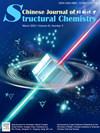Molecular conformational effects on co-assembly systems of low-symmetric carboxylic acids investigated by scanning tunneling microscopy
IF 5.9
4区 化学
Q1 CHEMISTRY, INORGANIC & NUCLEAR
引用次数: 0
Abstract
The assembly behaviors of two low-symmetric carboxylic acid molecules (5′-(6-carboxynaphthalen-2-yl)-[1,1′:3′,1′′-triphenyl]-3,4′′,5-tricarboxylic acid (CTTA) and 3′,5′-bis(6-carboxynaphthalen-2-yl)-[1,1′-biphenyl]-3,5-dicarboxylic acid (BCBDA)) containing naphthalene rings on graphite surfaces have been investigated using scanning tunneling microscopy (STM). The transformation of nanostructures induced by the second components (EDA and PEBP-C4) have been also examined. Both CTTA and BCBDA molecules self-assemble at the 1-heptanoic acid (HA)/HOPG interface, forming porous network structures. The dimer represents the most elementary building unit due to the formation of double hydrogen bonds. Moreover, the flipping of naphthalene ring results in the isomerization of BCBDA molecule. The introduction of carboxylic acid derivative EDA disrupts the dimer, which subsequently undergoes a structural conformation to form a novel porous structure. Furthermore, upon the addition of pyridine derivative PEBP-C4, N–H⋯O hydrogen bonds are the dominant forces driving the three co-assembled structures. We have also conducted density functional theory (DFT) calculations to determine the molecular conformation and analyze the mechanisms underlying the formation of nanostructures.

求助全文
约1分钟内获得全文
求助全文
来源期刊

结构化学
化学-晶体学
CiteScore
4.70
自引率
22.70%
发文量
5334
审稿时长
13 days
期刊介绍:
Chinese Journal of Structural Chemistry “JIEGOU HUAXUE ”, an academic journal consisting of reviews, articles, communications and notes, provides a forum for the reporting and discussion of current novel research achievements in the fields of structural chemistry, crystallography, spectroscopy, quantum chemistry, pharmaceutical chemistry, biochemistry, material science, etc. Structural Chemistry has been indexed by SCI, CA, and some other prestigious publications.
 求助内容:
求助内容: 应助结果提醒方式:
应助结果提醒方式:


